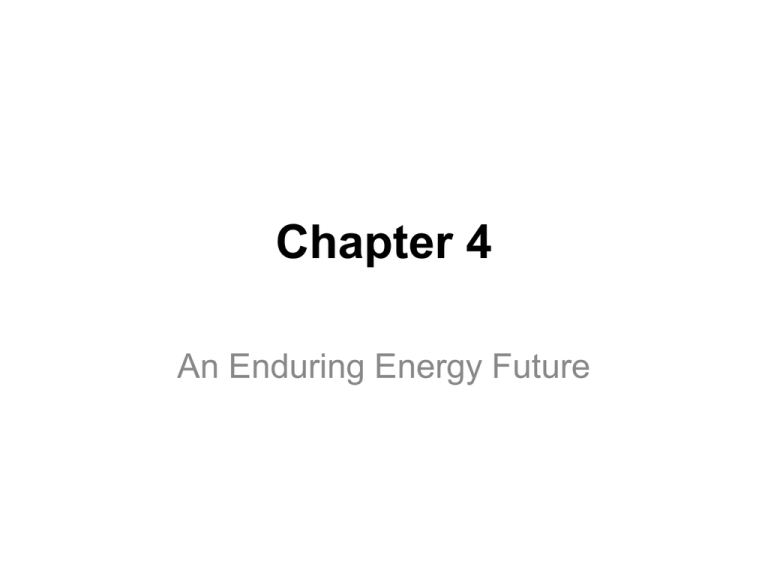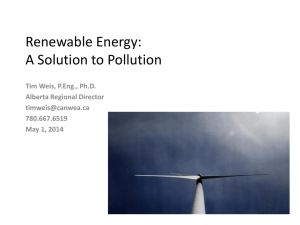Chapter 4 An Enduring Energy Future
advertisement

Chapter 4 An Enduring Energy Future An Enduring Energy Future In 1992, Gssing was a to wn in Austria that was considered one of the poorest areas. Nine years later in 2001, they became an energy self -suffi cient town. They produce biodiesel from the local rapeseed that is used for cooking oil and the production of anim al feed. They also use heat and power from the sun. New industries were buil t and openings for jobs expanded in the town. Today, Gssing has cut their carbon emi ssions by more than 90 percent. Many cities li ke Gssing are trying to come up with ways to lower their carbon emi ssions by creating low-carbon renewable energy. Even though most of the world is still not making efforts to stop poll ution and fossil fuels. Despite the economi c costs, threats to human health and the environment. Fossil fuels used to be cheap and abundant but since they were used so inefficiently their prices rose dramatically ! Cont. Globally the attention should be on the need to shift to wards renewable sources so they could reduce CO2 emi ssions and methane in order to reduce the effects of clim ate change. Comm ercial buil dings are being created to be more energy effi cient and even zero-net-energy buil dings that produce all its own energy on site with renewable energy and emi ts no CO2. The United Kingdom has consented that all new homes buil t after 2016 and all comm ercial buil ding made after 2019 must be zero-carbon. Solar heating and thermal storage in buil dings can lower additional heating and placement o f windows and roof shading can reduce cooli ng needs. Solar thermal panels are cost effective and can provide water and space heating. The development of Ņsmart gridsŅ, which use information technology to manage supply and demand will be important to achieving the full potential of renewables and multiple distributed storage devices. Most remaining problems are due to regulatory rules Smarter Central Power with large Scale Renewables キ Central electric generating stations will continue to be part of the electricity supply system in order to take advantage of an energy resource to meet large industrial or urban loads. キ Generating Capacity worldwide is now about 2 million MW, demand growth and the need to replace existing plans will require 6 million MW more by 2030 a cost of $5.2 trillion. キ Electricity Generation today accounts for 41% of global primary energy use. キ Thermal power plants typically convert only one third of the energy キ 5- 10 % of electricity is lost in transmission distribution and voltage adjustments. Cont. キ The Middle East, Asia, India, China, Australia and the U.S also have enormous solar resources. キ China’s wind resources alone could generate far more electricity than that country currently uses. キ United States wind energy in just a few states could meet a total national electricity demand. キ The United States, Egypt Brazil, Canada, China and Russia transmit power from Dams to cities hundreds of miles away. キ New lines were required to bring electricity from large nuclear facilities and from coal plants near mines. キ Renewable resources , including geothermal, biomass, ocean thermal, and hydro power can provide large scale base load power. In the United States, adding new transmission to transport wind energy from the Great Plains to population centers would yield large net economic savings for customers. • Smart grid technologies, now being installed in Africa, Asia, Europe, New Zealand and the U.S, will be able to smoothly integrate all types with renewables, electric vehicles Electrical storage facilities and distributed generation while enhancing grid reliability. •The Danish power company DONG is making conventional power plants more flexible so they can be turned down or even off, when the wind is blowing continued • As Reported by the German Aerospace Center DLR , projects that by 2030 renewables could generate at least 40% of national electricity in 13 out of 20 largest economies. • Wind, Hydro and biomass power will likely achieve the greatest market shares. • By tapping the potential of all renewables the world can move away from fossil fuel in the next decades,will not only create a more secure and far less polluting electricity but also reduce the threat of climate change. Heating and Cooling with Renewables •Heating and cooling account for 40-50% of global energy demand •Absorption cooling, bioheat, cogeneration, concentrating solar thermal, district heating/cooling, geothermal high-temp heat, ground-source heat pump, passive solar heating, passive cooling, seawater/lake cooling, solar thermal heat system -- these are some heating/cooling alternatives to fossil fuels (Pg. 140) •Several of these systems are available anywhere Waste Not, Want Not • • Heat expelled from power plants during electricity generation could meet the region’s demands for heating using district heating Energy recovery methods: – Waste heat, manure, food industry waste, landfill gas, wastewater, steam and gas pipeline pressure differentials, fuel pipeline leakages/flaring – In the U.S. these recovery methods could generate almost 100,000MW of electricity - enough to provide 19% of nation’s electricity • • • Fats & oils can be converted into renewable diesel and jet fuel Construction debris, waste paper, plastic, wood, lawn trimmings (anything containing carbon, oxygen and hydrogen) can be converted into some type of motor fuel Algae can convert as much as 80% CO2 released from coal/naturalgas fired power plants Scaling Up Renewables • Some analysts say renewable energy is too small-scaled and too dispersed to meet worlds energy needs. • However, if current growth rates continue, wind will generate more electricity than nuclear power in 2020. Scaling Up Renewables Continued • Energy is required to move away from fossil fuels. • Building massive numbers of new wind, solar, geothermal, and biomass plants will require large amounts of energy. • However, unlike conventional power plants, once most of these are built, they require no further energy to operate. Kicking the Habit • Shifting to renewable energy will require replacing an entire complex system. • To avoid catastrophic climate change, this transition must be accelerated. • Success stories should be scaled up, and strategies must be shared between countries. Kicking the Habit Continued • Several regulatory and policy changes could put humanity on course to avoid impacts of climate change. – Increase carbon prices over time – Taxing industry for their carbon emissions – Reward environmental innovation with tax breaks • This would give industry a reason to stop using carbon-intensive fuel and increase their use of renewable resources. Kicking the Habit Continued • Policies also need to be created to increase efficiency and reduce demand on an individual level. – Financial incentives (low-cost loans and tax benefits to purchase renewable and energy-saving technologies) – Tighten efficiency standards for lighting and appliances

